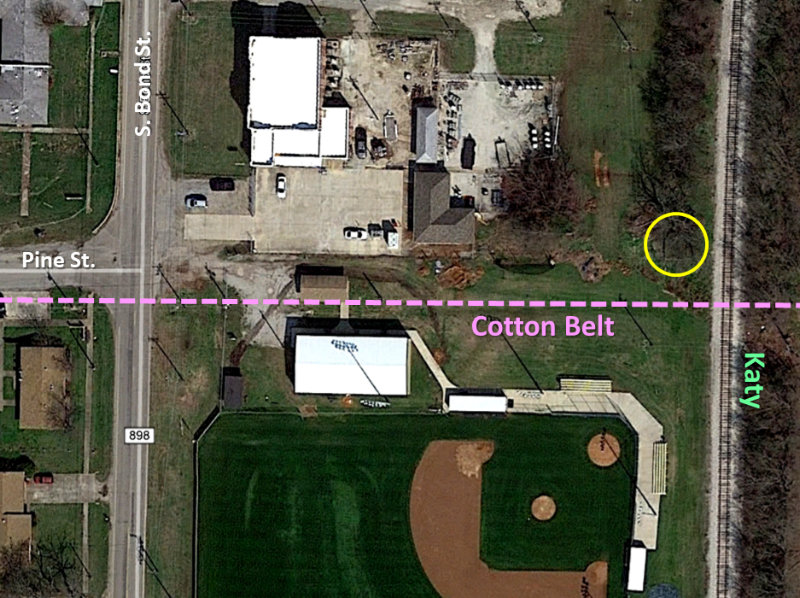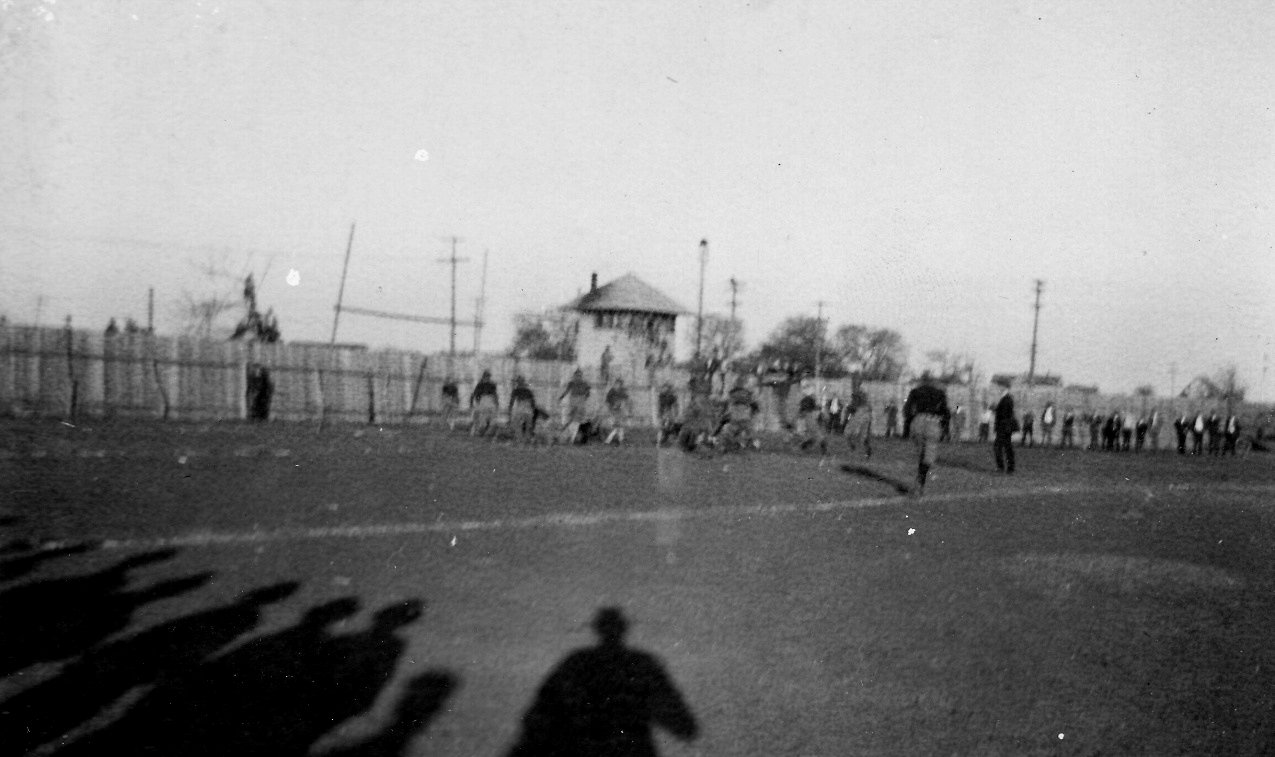
A Crossing of the Missouri-Kansas-Texas Railroad and the St. Louis Southwestern Railway

|
Above: The unidentified photographer that
snapped this photo of a football game in Whitewright in 1924 likely paid no
attention to the railroad structure looming in the background. Tower 101,
visible just beyond the fence, sat in the northwest quadrant of a
right-angle crossing of the Missouri Kansas Texas (MKT, "Katy") Railroad
(north/south) and the St. Louis Southwestern (SSW, "Cotton Belt")
Railway (east/west.) This view looks northeast toward the southwest corner of the tower.
The
lengthy spectator shadows give evidence of a fall
(football season!) day with the late afternoon sun low in the southwest.
From this perspective, the Cotton Belt double track is between the fence
and the tower (with the fence effectively serving as a safety barrier
for plays at the back of the end zone.) A signal post with both
semaphores in the down position is visible to the right of the tower,
adjacent to the Katy tracks which pass along its east side.
The photo does not offer obvious clues as to which railroad built it, but it was
almost certainly the Katy, whose line was substantially
busier and operationally more critical, carrying Texas Special
passenger trains between St. Louis and San Antonio. The Katy also had more nearby tower experience,
building at least three others along this track segment in
Denison,
Greenville and Celeste. This is the only image of
Tower 101 that has thus far been found. (Image courtesy of the
Whitewright Public
Library; special thanks to the
library staff for their
assistance.) Right: At full resolution, the blurry image may show spectators standing on a staircase on the south side of the tower. Although football is being played, the field is identified on Sanborn Fire Insurance maps of the era as a "Base Ball Park" including a grandstand (see map image below.) A century later, the site remains a baseball facility, but staff at the Whitewright Public Library confirm that it was also used for football until a new stadium was built at Whitewright High School in the 1980s. |
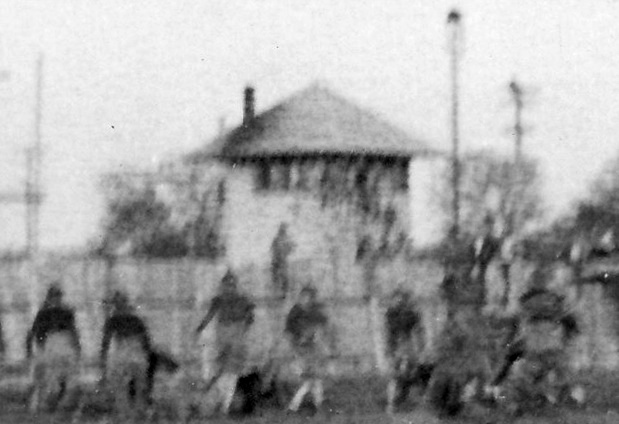 |
After the Missouri - Kansas - Texas (MKT, "Katy")
Railroad bridged the Red River in late 1872 and established a base of operations
in the new town of Denison, it proceeded no farther into Texas under its own
name for the remainder of the decade. Within a few years, investors saw an
opportunity to build rail lines out of Denison to serve as feeder routes for the
Katy. They were encouraged by the Katy, and there was at least a tacit
understanding that the Katy would work cooperatively with finished lines while
considering their potential acquisition. The first such effort was chartered as the Denison & Southeastern (D&S)
Railway in 1877. The goal of the D&S was to build from Denison to the town of
Greenville, about fifty miles southeast. Greenville was a good target because
the East Line & Red River (EL&RR) Railroad had arrived there in 1876, having built 120
miles of track from Jefferson, the sixth largest town in Texas
which was also a major river port near the Louisiana border. As the EL&RR paused
in Greenville to raise additional capital before proceeding with its plan to
build to McKinney, the D&S
initiated construction from Denison to Greenville to establish a through route between Denison and
Jefferson.
The D&S Board of Directors was almost exclusively New York
financiers and venture capitalists. One of them, William Whitewright, took
advantage of his knowledge of the expected route and bought land in its path,
planning to profit from selling real estate at a new town he would establish. He
founded his namesake city in early 1878 and began preparing for the tracks to
reach Whitewright. When they did, he arranged an excursion train to operate out
of Denison on April 17, 1878 to bring crowds to Whitewright for an auction of
town lots. The D&S did not build beyond Whitewright for two years, but during
that time, regular trains were operated by the Katy between Denison and
Whitewright. It's doubtful the D&S ever intended to acquire their own rolling
stock since the intention all along was to make the line sufficiently attractive
that the Katy would buy it. Presumably the Katy paid the D&S for the privilege
of using their tracks; evidence of the existence of a formal lease has not
surfaced.
During this period, another railroad, the Denison &
Pacific (D&P) was chartered to build west from Denison to Gainesville, a
distance of 42 miles. One of the individuals involved early on was Ben
Munson, who was arguably the founder of Denison.
Within a year, the line was abandoned. In January, 1880, a newspaper report
suggested that both the D&S and the D&P had been acquired by a financial group
run by stockholders and bondholders of the Katy, presumably major investors who
intended to shore up the value of these two railroads by extending them to
become attractive for the Katy. On March 11, 1880, the D&S acquired the D&P.
Twelve days later, the D&S modified its charter to include the westward
expansion while also taking a new name: the Missouri, Kansas &
Texas Extension Railway. Under that name, the railroad resumed and completed its
construction from Whitewright to Greenville during the remainder of 1880. The
Katy bought "the Extension" in November, 1881.
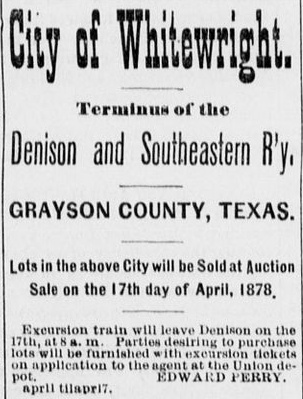 |
Left: Promoters of the new city of Whitewright
placed this advertisement in the Dallas
Daily Herald of April 10, 1878. The ad announces an excursion
train to run out of Denison on April 17th for an auction of
town lots in Whitewright. Excursion tickets were available to be
purchased "at the Union depot" in Denison. The cryptic notation at the
bottom of the ad indicates it is to be repeated in each daily issue of
the newspaper from April 11th through the 17th, the day of the auction. Right: area map for railroads in the vicinity of Whitewright Railroad Abbreviations: Katy, Missouri - Kansas - Texas Cotton Belt, St, Louis Southwestern T&P, Texas & Pacific H&TC, Houston & Texas Central SL-SF, St. Louis - San Francisco ("Frisco") KO&G, Kansas, Oklahoma & Gulf |
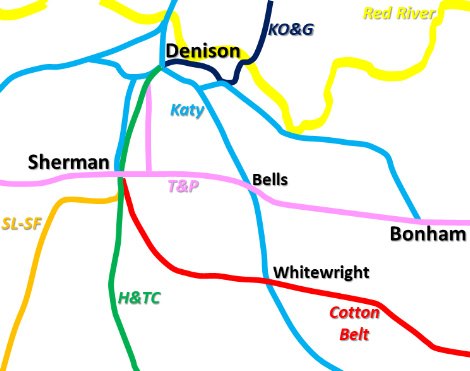 |
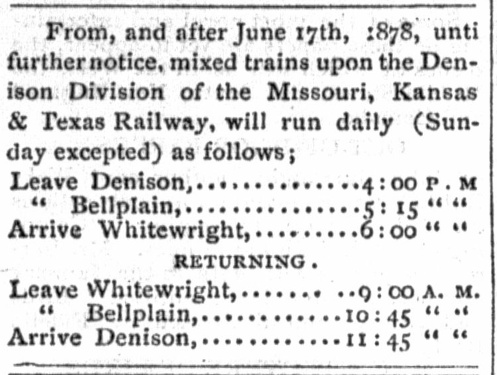 |
Left: Two months after the excursion train to Whitewright for the town lot auction, the Denison Daily News of June 17, 1878 published this schedule for service by the Katy from Denison to Bellplain (later named Bells) continuing to Whitewright and return. This was obviously on the D&S tracks yet it conveys the reality that within a couple of months of the first trains to Whitewright, the route was publicly operated by the Denison Division of the Katy. Right: The January 28, 1879 edition of the Denison Daily News reported that Katy's agent at Bellplain was visiting Denison. The existence of a Katy agent at Bellplain is further evidence that the Katy was operating the D&S under some arrangement. |
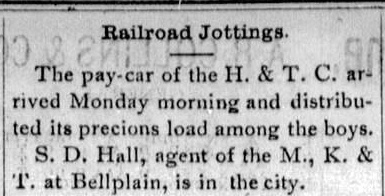 |
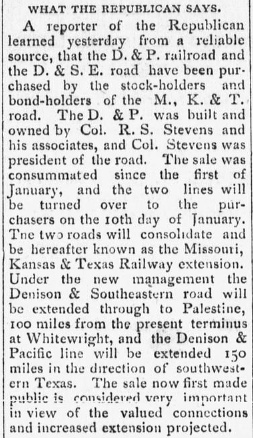 |
Left: The Denison Daily News of January 8, 1880 repeated a news item from another newspaper ("the Republican", location unknown) that a group of stock and bondholders of the Katy railroad had arranged the investment capital to buy both the D&S and the D&P. Supposedly the sale had been consummated during the first week of January and the lines would be combined into a new railroad, the Missouri, Kansas & Texas Railway Extension. This is an early reference to "Extension"; the railroad would ultimately become the Missouri, Kansas & Texas Extension Railway. Despite the apparent plans of the new management, the southeastern extension to Palestine only made it as far as Mineola. The southwestern extension, "150 miles" with no specified endpoint, ended up being northwest to Wichita Falls (and beyond into Oklahoma by acquisition.) Both extensions were executed by the Katy. Right: The Denison Daily News of April 15, 1880 reported that a contract had been let to John Scullin to extend the rail line from Whitewright to Greenville. The article references the railroad as the "Denison & Southeastern railroad, now owned and operated" by the Katy. The reporter may not have been aware that D&S had been re-chartered a month earlier as the Missouri, Kansas & Texas Extension Railway. The story conveys the reality on the ground that this was a Katy operation all the way, regardless of who owned the tracks and when the legal paperwork might catch up. It is interesting to note that the contractor, John Scullin, had been one of the founders of the D&P. |
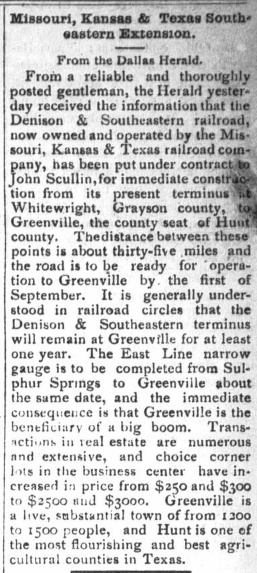 |
In 1887, the St. Louis, Arkansas & Texas (SLA&T) Railway built a 109-mile branch to Sherman from their main line at Mt. Pleasant, crossing the Katy at Whitewright. Two years later, the SLA&T went into receivership and the property was conveyed to the St. Louis Southwestern (SSW, "Cotton Belt") Railway. Served by two railroads, Whitewright prospered as the principal supply and shipping center for the agriculture-based economy in the area. The population peaked at 1,804 in 1900 and remained relatively stable after that. On December 1, 1914, Tower 101 was authorized for operation by the Railroad Commission of Texas (RCT) to control the Katy/Cotton Belt crossing. It was a 2-story manned tower of stucco construction incorporating a 23-function manual interlocker.
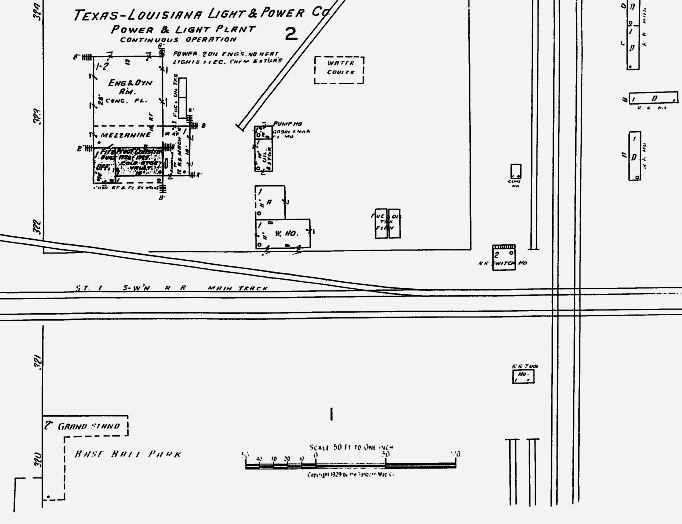 |
Left:
The 1929 Sanborn Fire Insurance Company map of Whitewright shows the
crossing of the two railroads four blocks south of downtown. Both
railroads had double tracks at the crossing due to lengthy siding tracks
in town. As shown below,
the depiction of the tower on the 1929 map changed from the 1920 map.
Both maps identify the tower as a 2-story structure, but they differ on
the location of the door opening ("o"). Unless there's a map
error, this indicates that the
tower was rebuilt (or substantially modified) between those dates. If a
staircase is visible in the 1924 tower
image above, the door seems to be nearer to the southwest corner, not the
southeast corner as the 1920 map suggests. By 1929, the staircase
would not be visible from the football field, i.e. if there really is a
door near the southwest corner, then the 1924 image
matches neither map precisely.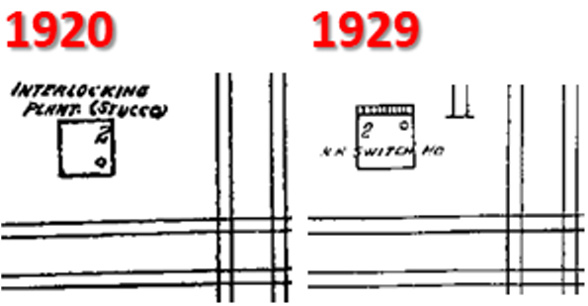 |
Right: This c.2008 "birds eye view" image from
Microsoft Visual Earth has been annotated to show the rights-of-way at
the former Tower 101 crossing. The tower's foundation is visible and it
remains intact today. The baseball field is also still in use. The
former Katy tracks remain operational, now belonging to Genesee &
Wyoming, Inc. and operated by two of its subsidiaries: the Texas
Northeastern Railroad and the Dallas, Garland & Northeastern Railroad. Near Right: This 1959 aerial image shows that when lined for football, the field was played parallel to the Katy tracks. By 1959, the Cotton Belt tracks had been abandoned (1953) and removed. The tower was no longer intact, but its foundation is clearly visible in the upper right corner of the image as a white rectangle. ((c)historicaerials.com) |
 |
Telegraph Service at Whitewright
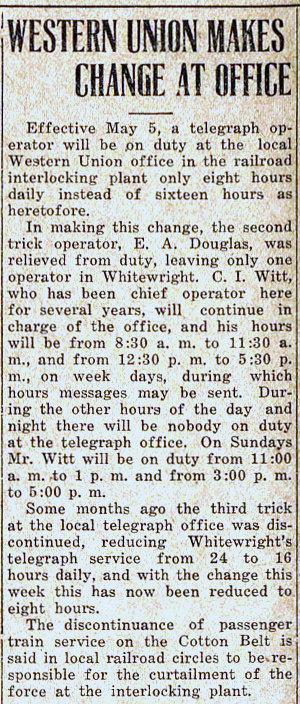 |
Over the years, there were various changes to the local telegraph
service provided by the railroads to the Whitewright community. Left: The Whitewright Sun newspaper of May 5, 1932 detailed that telegraph operations in the "interlocking plant" were becoming daytime only, 8 hours per day. The story mentions that months earlier, the service had been cut back from 24 hours to 16 hours. This appears to have resulted from a staffing reduction in the tower that was blamed on the Cotton Belt eliminating passenger service to Whitewright. The story implies that previously, there had been a late night Cotton Belt passenger train that had justified the need for 24/7 staffing in the tower. Right: A year later, the Whitewright Sun reported on July 13, 1933 that daytime telegraph operations were being moved from the tower to the Katy depot. Apparently, a change to the Cotton Belt's schedule resulted in the need for a tower operator overnight and eliminated the need to staff the tower during the day. The implication is that under the revised schedule, the Cotton Belt ran zero trains through Whitewright during the day, so it was acceptable to line the signals for unrestricted passage on the Katy and leave the tower unmanned. |
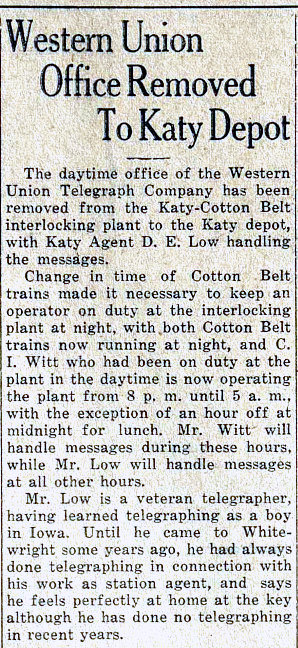 |
Below:
Approximately two months after the July 13 article, the
Whitewright Sun
reported on September 7, 1933 that an additional change was being made to
Whitewright's telegraph operations, reinstating night time service at
the tower. But "night only" service at the tower had been announced in
the July 13 article, so it appears that there was yet another change
about "four weeks" earlier (approximately August 10) where the night telegraph service at
the tower had been eliminated.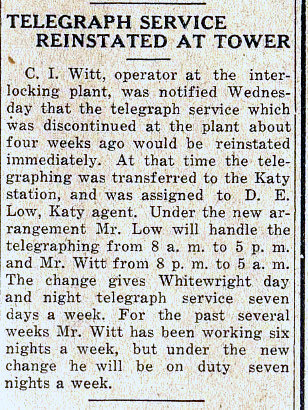 |
Automation of the
Interlocker
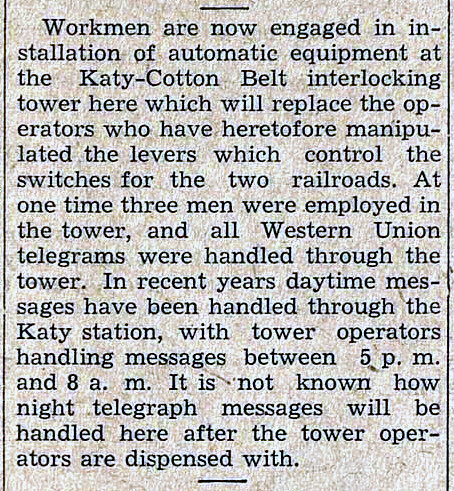 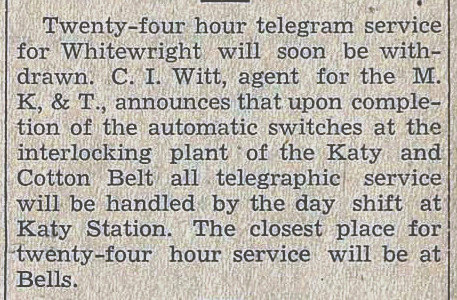 |
Upper Left: The Whitewright Sun
of October 14, 1943 briefly mentioned that the crossing at the "Katy -
Cotton Belt interlocking tower" was in the process of being upgraded
with "automatic equipment" which would eliminate the need to staff the
tower. Lower Left: On November 11, 1943 the Sun reported the upcoming impact to telegraph service in Whitewright due to the impending closure of the tower. The town of Bells (~ 8 miles away) was identified as the nearest location with 24-hour telegraph service, presumably at Tower 20. Right: On Thursday, December 9, 1943, the Sun gave the new automatic interlocker a small headline as it announced that the tower was no longer staffed. Significantly, the story identifies C. I. Witt as a Katy agent and states that two other operators are being transferred to Gainesville and Celeste respectively, both of which were locations with Katy interlockers. It is safe to assume that Tower 101 had been staffed exclusively by Katy employees which tends to confirm that the tower was built by the Katy. (Railroads shared tower expenses for maintenance and staffing, but in most cases, only one railroad supplied the tower personnel.) Although a separate equipment cabin could have been used, it seems likely that the new system was installed in the bottom floor of the tower and that the tower remained in place, though unmanned. If so, the tower was probably removed shortly after the Cotton Belt abandoned its tracks through Whitewright in late 1953. The major headlines (below) in the same issue of the Sun put the timing of the automatic interlocker upgrade into perspective. 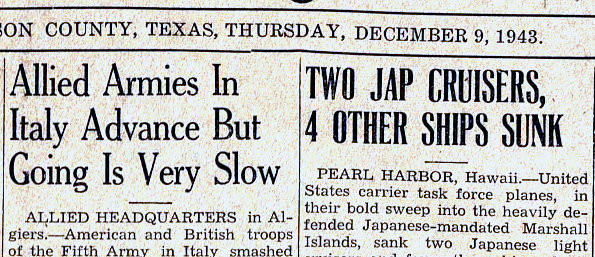 |
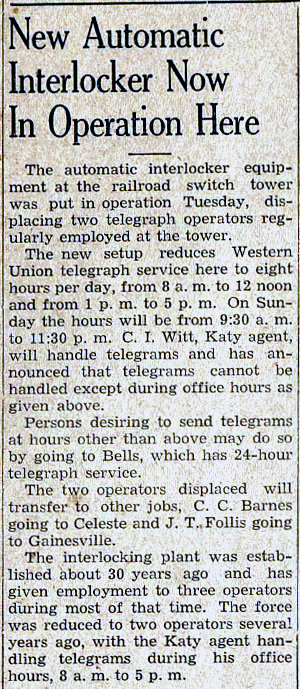 |
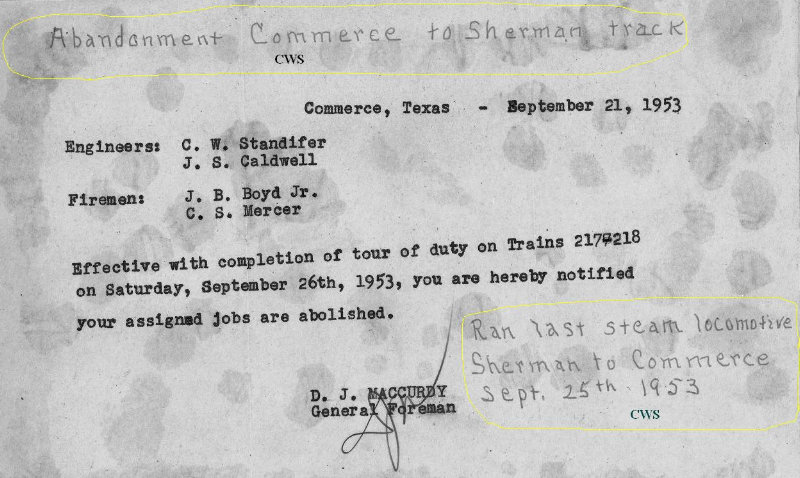
Above: The Cotton Belt issued
this notice to affected personnel that the final run of a Cotton Belt train
from Commerce (through Whitewright) to Sherman and back would occur on
September 25-26, 1953. The handwritten annotations were made by C. W. Standifer,
one of the affected employees and the subject of a
book by Ed Cooper. Most of the former Cotton Belt right-of-way between
Commerce and Sherman (but not
the section through Whitewright) was used to create Texas Highway 11. (Ed Cooper collection)
Below: This Google Earth
image of the vicinity of Tower 101 has been annotated to show the location of
the foundation for the tower (yellow circle) and the former Cotton Belt
right-of-way. The industrial facility north of the baseball field is a
substation and office for Texas New Mexico Power Co. that was built in 1929 as a
power plant by
the Texas-Louisiana Light & Power Co. The Katy supported the construction effort
with a spur track (shown on the 1929 Sanborn map above) for offloading heavy
equipment. The main building's architecture and
the surrounding site appearance is sufficiently interesting that the Texas Film
Commission identifies it as a
location for shooting movie scenes.
